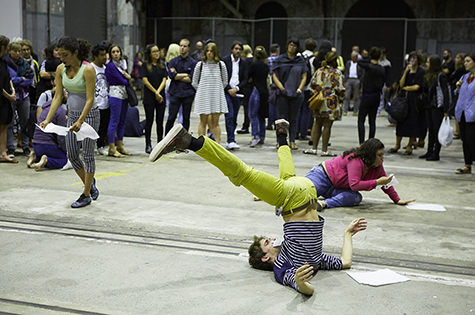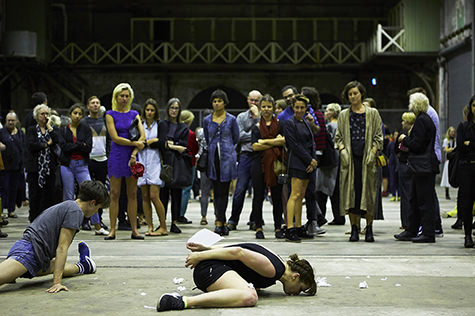Compulsion’s fraught harmonies
Keith Gallasch: Boris Charmatz, Musée de la danse, Manger

Manger, Musee de la Danse, Carriageworks, 2016
photo Zan Wimberley
Manger, Musee de la Danse, Carriageworks, 2016
A huge, tired, unused Carriageworks space, flatly and brightly lit. Thirteen performers scattered singly through the space, lying stretched out or writhing on cold unforgiving concrete or standing and slowly consuming A4 sheets of paper—each performer has a neat stack—murmuring, groaning, speaking, self-preoccupied. For an hour or so their obsessiveness, feigned hunger and pain will escalate as we wander from dancer to dancer, attracted by a wild cry or a sudden display of extreme movement or, pausing, recognising a yoga-like pose or intrigued by a strangely graceful movement.
A crowd gathers about a performer building small houses with her paper. We catch words in French and sometimes English, spoken as the performers chew and gulp down paper in an apparently mindless continuum of ingestion and expression. Some of us glance at the text in the program—shouted, variously pitched, spoken and sung. It’s Un homme de merde (Shitman), excerpted from a poem by Christophe Tarkos in which the speaker encounters a man whose appearance, his innards, his brain (“two turds of very dense shit”), his thoughts and his dance are all shit. The delivery is shrill or guttural, wrenched from the inside. The image of humanity reduced to valueless function appalls the performers—“It can’t be that a man is completely full of shit”—but they continue to eat and contort, living their shit lives.
Slowly swelling up from these disparate abject bodies come harmonious voices, singing the beautiful Allegretto from Beethoven’s 7th Symphony. The song fills the vast space, connecting performers far distant from each other, making us all, for the moment, one. This choral togetherness comes as a relief, however the singers’ faces yield no shared joy. The song fades. It’s as if beauty is real but incidental, a residue of a lost culture.
A grim communality ensues, as couples and trios form, twisting arms and legs, standing on each others’ feet or hands and torsos, on bodies which gasp and choke, coughing up chewed paper. Where pain first seemed internal now it is imposed with brutal realism. A contorted, interlocked foursome appears like a living sculpture. At one end of the space a performer, standing tall and repeatedly executing a strange twisting leap, is gradually joined by others as he sings Tom Waits’ “King Kong,” a grinding, bluesy chant: “they shot him down/ they thought he was a monster/ but he was the king.” Again, widely scattered individuals come together in song, this time lamenting human arrogance and further evoking a species that has debased itself.
A kind of slow panic completes the work, each performer nibbling small paper leftovers picked up from the floor or hurriedly gorging their last sheets. They all gather in the centre of the floor, some licking fingers, until the last of the paper is consumed, soft voices resonate (“you have made me smile again,” though no one does) and the one performer still moving completes his compulsive little dance. Stillness. Exit.
Speaking with Biennale director Stephanie Rosenthal after his 20th Biennale of Sydney keynote address, Boris Charmatz, the choreographer of Manger, said, “I am more visited by dance than I visit dance.” Manger’s sheer strangeness was a visitation, a work that created its audience rather than playing to it. We were uncertain where to put ourselves; we looked for dance (where were the steps?); we became anxious (the performers’ suffering looked too real, the floor too hard for them, the paper picked from the floor likely toxic); we were surprised and embraced by the swell of choral voices; we were distressed by the darkness of Charmatz’ vision, its violence and utterly tenuous sense of community so central to Charmatz’ work, in public spaces and with the public. We know from his keynote address that he despairs over the diminution of public space. Dance, he thinks, can regenerate it. However, Manger, with its fecal imagery, suffering, torments and only temporary respite, suggested, indeed induced, a profound anxiety about the state of human communality.

Manger, Musee de la Danse, Carriageworks, 2016
photo Zan Wimberley
Manger, Musee de la Danse, Carriageworks, 2016
At the end we welcomed small signs of togetherness and vigorously cheered the performers, who might not have danced recognizable steps, but whose trained, expert bodies could express with movement at once raw and precise the extent and depth of human pain and cruelty and with their voices the sound of hope. Manger appears to be a work of protest, one against ourselves. But you wouldn’t know that reading Charmatz’ stream of consciousness program note which focuses on the mouth, eating, singing, swallowing, “the Dance in the palate In the teeth In the tongue and above all with no end…” But the bodies in Manger do more than eat and sing.
Manger literally means ‘to eat’ and the poem which provides the text for the work is The Shitman. While there was eating in Manger (of rice paper standing in for the real thing) and much more in the way of physical activity, I recall no evocation of shitting (such were the bodily contortions, cries and grunts, there may well have been), just the all too vivid metaphorical images of Tarkos’ excremental poem. Physical performance in Manger, though delivered with Artaudian force, stops short of the scatological.
When interviewed by Francois Truffaut, Alfred Hitchcock revealed he’d fantasised making a film about 24 hours in the life of a city, commencing “at 5am, at daybreak, with a fly crawling on the nose of a tramp lying in a doorway.” The film would track the arrival of all the city’s food supplies and follow them all day, cooked and consumed and “showing the sewers and the garbage being dumped out into the ocean… the cycle would show what people do to good things…[The] theme might almost be the rottenness of humanity” Hitchcock (1968). Charmatz only goes so far: “the choreography of people also becomes a choreography of food that traverses the inside of space then of the body the essence is packed down the throat we don’t want to die…” The Shitman text aside, Charmatz’ vision in Manger is not excremental, although it shares some of scatology’s unblinking view of the fundamentals of our existence, making for an unnervingly powerful, complexly suggestive and viscerally memorable work.
.jpg)
Manger, Musee de la Danse, Kunstenfestivaldesarts-Bozar, 2015
photo Benjamin Boar
Manger, Musee de la Danse, Kunstenfestivaldesarts-Bozar, 2015
20th Biennale of Sydney, Musée de la danse, Manger, choreographer Boris Charmatz, Carriageworks, Sydney, 19 March
RealTime issue #132 April-May 2016, web






